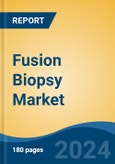Transrectal is the fastest growing segment, North America is the largest market globally
Speak directly to the analyst to clarify any post sales queries you may have.
10% Free customizationThis report comes with 10% free customization, enabling you to add data that meets your specific business needs.
Key Market Drivers
The increasing global prevalence of prostate cancer is a primary market driver, fueling demand for precise diagnostic tools. With new diagnoses consistently rising, advanced detection methods are critical for improved patient outcomes. According to the International Agency for Research on Cancer's Global Cancer Observatory, in 2022, approximately 1.5 million new cases of prostate cancer were reported globally, underscoring this persistent demand. Simultaneously, continuous advancements in medical imaging technologies significantly impact market expansion. Improvements in MRI and ultrasound systems, with sophisticated software, enhance fusion biopsy precision. These technological evolutions enable more accurate lesion identification.Key Market Challenges
The elevated cost associated with fusion biopsy systems and procedures, alongside challenges in securing comprehensive reimbursement, significantly impedes market expansion. The high capital investment required for these advanced diagnostic platforms creates a substantial financial burden for healthcare providers. This limitation particularly affects institutions with restricted budgets and healthcare systems in developing economies, curtailing their ability to acquire and implement fusion biopsy technology.Key Market Trends
The integration of Artificial Intelligence and Machine Learning is a significant trend transforming the global fusion biopsy market by enhancing diagnostic accuracy and procedural efficiency. AI algorithms analyze complex imaging data, such as MRI, to identify suspicious lesions with greater precision, reducing inter-operator variability and potentially lowering healthcare costs. This technological advancement also facilitates more efficient workflows, with AI systems capable of optimizing lesion segmentation and image texture analysis.Key Market Players Profiled:
- Eigen Health Ltd
- Koninklijke Philips N.V.
- Hitachi, Ltd.
- MedCom Inc
- Esaoate SpA
- KOELIS SAS
- Focal Healthcare Inc
- UC-Care Medical Systems Ltd.
- GeoScan Medical
Report Scope:
In this report, the Global Fusion Biopsy Market has been segmented into the following categories:By Biopsy Route:
- Transrectal
- Transperineal
By End-User:
- Hospitals
- Diagnostic Centers
- Ambulatory Care Centers
By Region:
- North America
- Europe
- Asia Pacific
- South America
- Middle East & Africa
Competitive Landscape
Company Profiles: Detailed analysis of the major companies present in the Global Fusion Biopsy Market.Available Customizations:
With the given market data, the publisher offers customizations according to a company's specific needs. The following customization options are available for the report:- Detailed analysis and profiling of additional market players (up to five).
This product will be delivered within 1-3 business days.
Table of Contents
Companies Mentioned
- Eigen Health Ltd
- Koninklijke Philips N.V.
- Hitachi, Ltd.
- MedCom Inc
- Esaoate SpA
- KOELIS SAS
- Focal Healthcare Inc
- UC-Care Medical Systems Ltd.
- GeoScan Medical
Table Information
| Report Attribute | Details |
|---|---|
| No. of Pages | 180 |
| Published | November 2025 |
| Forecast Period | 2024 - 2030 |
| Estimated Market Value ( USD | $ 618.92 Million |
| Forecasted Market Value ( USD | $ 1010 Million |
| Compound Annual Growth Rate | 8.6% |
| Regions Covered | Global |
| No. of Companies Mentioned | 9 |









